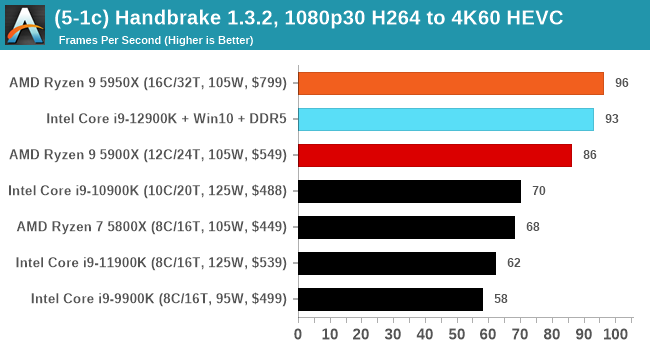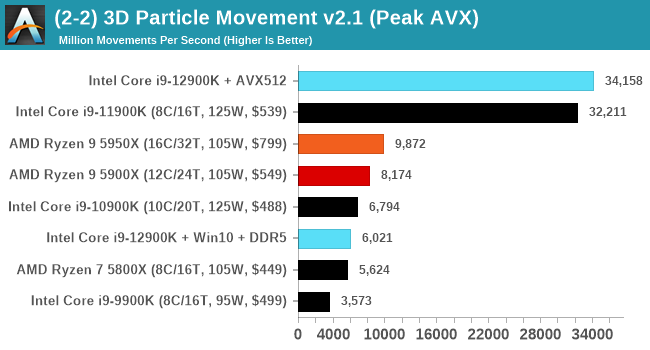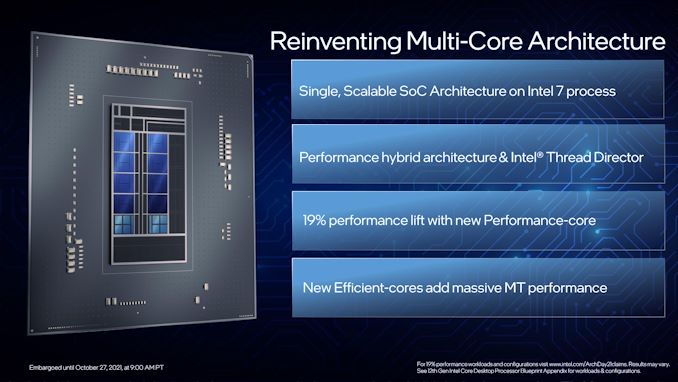The Intel 12th Gen Core i9-12900K Review: Hybrid Performance Brings Hybrid Complexity
by Dr. Ian Cutress & Andrei Frumusanu on November 4, 2021 9:00 AM ESTConclusion: Variables Maketh the CPU
Suffice to say, Intel’s new 12th Generation Core family has added more variables to the mix than a traditional processor launch. The combination of different types of core, coming at a time where a new operating system has just been launched, but also at the inflection point of a new type of memory. Let’s break down some of the differences we’ve observed in our testing.
When we compare Windows 10 to Windows 11, purely on throughput benchmarks, we don’t find much difference. There are a few spots where Windows 11 has a slight advantage in multi-threaded workloads, but this comes down to how new threads are spawned between the performance cores and the efficiency cores. Intel stated that the performance between the two, at least for CPU workloads, should be within a few percentage points, stating that Windows 11 should have lower run-to-run variance. We can corroborate this in our testing. Windows 10 also had some scheduling issues with low priority threads, which we expect to be ironed out with updates.
Comparing the new DDR5 to the old DDR4 is a different story, as the new memory standard offers a substantial uplift when it comes to memory bandwidth. As we saw recently with the M1 Max review, sometimes memory bandwidth can be a limiting factor. In our testing, DDR5 had a minor lead in single threaded tests but in a lot of multithreaded tests, the lead was significant. For real world, we had examples of +14% in Agisoft, +10% in NAMD, +8% in V-Ray, +10% in Handbrake, and +20% in WinRAR. In SPEC2017, we saw a couple of single threaded workloads get +15% improvements over DDR5, but in multi-threaded this was up to +40% on average, or more than 40% in specific tests. This also comes down to the doubled memory channels (4x32-bit vs 2x64-bit) which can be better utilized on top of the bandwidth increases.
Now comparing the P-core to the E-core, and it’s a story of how the E-core individually can perform on par with a Skylake core. Having eight extra Skylake-class cores is nothing to be sniffed at. In a lot of tests the E-core is half the performance of the P-core, but the P-core is itself is now the market leader in performance. The Golden Cove core inside Alder Lake has reclaimed the single-threaded performance crown with an uplift in SPEC of 18-20%, which is in line with Intel’s 19% claim. This puts it ahead of Apple’s M1 Max or 6% (int) and 16% (fp) ahead of AMD’s Zen 3 core.
The Core i9-12900K
Combining fast P-cores, Skylake-class E-cores, and DDR5 into one package means that Intel has certainly jumped from behind the competition to in front of it, or at least in the mix. When you have your operating system set up just right, and no issues with schedulers, it outperforms AMD’s offering when single core performance matters, and in multi-threaded workloads, it does tend to sit somewhere between a 5900X and a 5950X.

It’s important to note that in some tests, the Core i9-12900K does win outright. It’s at this point we should consider how much is core related vs standards related: DDR5 has produced somewhat of an uplift, and the competition is expected to claw some of that back when they introduce it, but those products are expected more towards the latter half of 2022. For users with those specific workloads today, and willing to pay the DDR5 early adopter tax, Alder Lake can provide performance uplifts right now.

Power is an interesting topic, and although our peak power numbers when all cores were loaded were above the 241W Turbo power on the box, in real world workloads it didn’t tend to go that high. The P-cores alone on the chip matched the power consumption of Intel’s 11th Generation in AVX2 workloads, but adding in the E-cores does put it over the previous generation. I’m not entirely sure what that says about Intel’s 7 manufacturing process compared to the 10SF used before. A lot of the performance gains here appear to come from IPC and DDR5, and that doesn’t seem to have come with performance per watt gains on the P-cores. It means that Intel is still losing on power efficiency at load compared to the competition.

I have to say a side word about AVX-512 support, because we found it. If you’re prepared to disable the E-cores, and use specific motherboards, it works. After Intel spent time saying it was fused off, we dug into the story and found it still works for those that need it. It’s going to be interesting to hear how this feature will be discussed by Intel in future.
Overall though, it’s no denying that Intel is now in the thick of it, or if I were to argue, the market leader. The nuances of the hybrid architecture are still nascent, so it will take time to discover where benefits will come, especially when we get to the laptop variants of Alder Lake. At a retail price of around $650, the Core i9-12900K ends up being competitive between the two Ryzen 9 processors, each with their good points. The only serious downside for Intel though is cost of switching to DDR5, and users learning Windows 11. That’s not necessarily on Intel, but it’s a few more hoops than we regularly jump through.











474 Comments
View All Comments
5j3rul3 - Thursday, November 4, 2021 - link
Great step for intelBobbyjones - Thursday, November 4, 2021 - link
Indeed. Biggest improvements since sandybridge. If you look at the timeline, this wouldve been the first CPU designed since they saw Zen 1. This is their Zen 1 moment and they already took the performance crown back basically across the board and at a lower price. AMD is now on the back foot, and it will be another whole year before Zen 4, and the thing is, Zen 4 isnt even competing with Alder Lake, Raptor Lake is rumored to be out before Zen 4. AMD has really screwed up with their launch cycle and given Intel so much room that they not only caught back up but beat them. Intel is truly back.Netmsm - Thursday, November 4, 2021 - link
For now Threadripper has the performance crown.With this performance per watt, Intel can just win the market for PCs.
Enterprise will never accept this performance per watt! So, AMD wins the high profitable enterprise market.
12900k guzzles power up to 241! whereas 5950x consumes half!
Considering power consumption, it's like a Pyrrhic victory for Intel.
fazalmajid - Thursday, November 4, 2021 - link
The HEDT market in Enterprise is workstations, which run certified apps like AutoCAD and has a lot of inertia. The first real Zen workstation is the Lenovo P620 and it only recently came out, so AMD hasn't conquered that market yet. Most actual Enterprise desktops are compact models that typically run on laptop CPUs.DominionSeraph - Friday, November 5, 2021 - link
And Intel has AMD beat for miles in system validation.My 3950X on a x570 Phantom Gaming X has major issues with disk access across one NVMe, one SATA SSD, and two HDDs. Some things will start up fine, but some things will just HANG. Deus Ex loading screens take like 10 seconds. I just tried to play a video off my NVMe and it took ~15 seconds for it to launch MPC-HC. (further launches are fine.) MeGUI takes 15 seconds to launch.
This thing is just frustratingly slow in general desktop tasks compared to my old i7 4790.
Does it beat the pants off the 4790 in heavily multithreaded crunching? Yes. But iAMD does not put out a quality product.
Gothmoth - Friday, November 5, 2021 - link
anecdotal evidence? ....YOU have issues with your system.well we have 16 core ryzen and threadripper 32 & 64 core systems at work and we can´t complain.
it´s not as if intel is issue free (and i am not taking about security flaws).
when you have such grave issues.. YOUR system has issues.
probably a bad setup. i did not hear that starting MPC needs 15 seconds when i read abourt AMD systems.
dotjaz - Sunday, November 7, 2021 - link
What about USB issues that are publicly acknowledged AND multiple BIOSes claim to have fixed it, yet here we are.Netmsm - Friday, November 5, 2021 - link
It is your problem not AMD nor Intel!This is why we always refer to QVL of MB before buying RAM, SSD, etc. to avoid such problems. It is not AMD prerogative rather it is for all platforms.
For now you may better update MB bios as soon as it is released. To solve the problem completely you need to reassemble it according to the MB's QVL.
DominionSeraph - Friday, November 5, 2021 - link
It is an AMD issue. I've put together hundreds of Intel systems and none of them have any issues.Netmsm - Friday, November 5, 2021 - link
When you face abnormality just put your cards on the table and ask a pro.